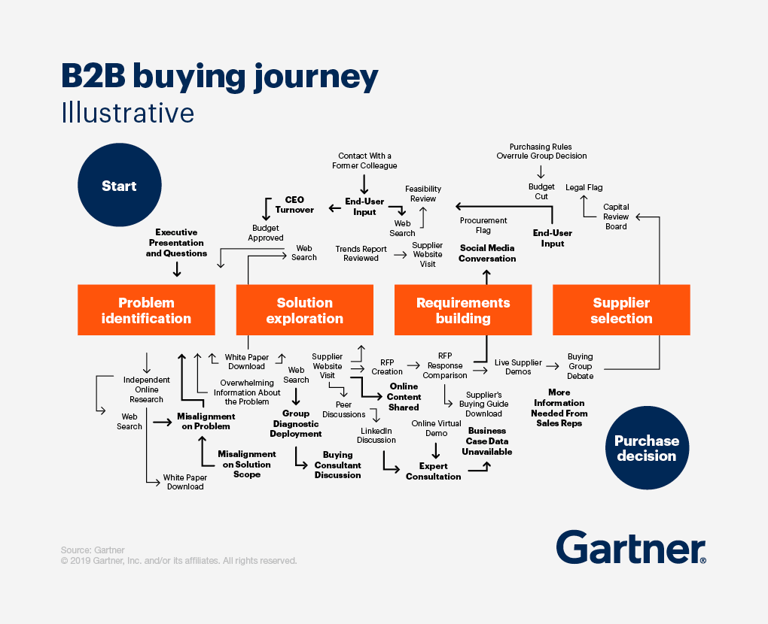
“Digital marketing is all attributable, isn’t it?” That’s what the CEO asks, but the reality is more complicated, especially in B2B settings. Changes in the more than a decade of doing paid campaigns for B2B businesses mean that being able to say spending X got you Y is harder now than ever. But why?
Impact of Cookie & Privacy Changes
A properly implemented cookie banner and policy has typically caused a 40% drop in tracked traffic on B2B websites. Why accept tracking cookies when you don’t need to? This is just the tip of the iceberg though. Apple’s policy of Safari removing cookies after just 24 hours as well as the adoption of browsers such as Brave and Firefox means that cookies for tracking are disappearing faster, if they are even implemented at all from a site visit. A B2B purchase doesn’t typically happen quickly and so this has hurt attribution to all channels, including paid more in B2B than B2C. However, this is just a part of the answer to the question.
Greater Cost = Greater Attention
Good leaders focus on what makes the big differences. A decade ago, the number of B2B companies doing broad and deep paid campaigns was a fraction of what it is now. The bids have increased. The budgets have increased. Crucially for many businesses, the importance of paid mediums as a channel for leads and sales has also increased much more. These things have put more emphasis on making sure this important channel is working well; at a time when the technical changes mean that it is harder to see that. Competition online and in organic search has also put more focus on paid campaigns as competitors have splintered the traffic. All this attention means that marketing leaders are under the microscope when it comes to their paid spending in B2B to demonstrate not simply that it is profitable overall but that each component / campaign in the paid mix is worthy of the budget allocated to it.
Complexity of the B2B Sales Journey
The biggest issue with B2B sales, especially enterprise ones, is the complexity of the journey. If you are going to spend potentially thousands, hundreds of thousands or even millions on something, you are not going to rush it. Additionally, making a purchase that is going into a business may also have far reaching or strategic impacts beyond their cost. Buying the new bottling line isn’t simply about its cost but the impact if it is not reliable could shut the factory. The new digital workplace solution isn’t just about the per user per month cost to the enterprise but will it actually breakdown silos and mean more multi-million innovations make it to market faster. With these kind of impacts, B2B purchases don’t get rushed. There is going to be investigation into the root cause of the issue. Explore the potential solutions. Look at competitive alternatives. Read industry influencers’ comments on the subject. Discuss this internally. This is all complexity.

Source: Gartner
The B2B Decision Making Unit (DMU)
With such big impacts across an organisation, they are not going to let one person alone make the decision. An organisation will have a formal or informal decision-making unit or DMU. The size and formality of the DMU will typically be dependent on both the impact of the decision and the size of the organisation. The bigger the DMU, the harder it is going to be for you to measure the impact of your paid campaigns. This is due to the way that your tracking works for both paid platforms and deals.
For a deal / opportunity / sale to be attributed to a channel, like paid, the person who the deal was first associated with has to be shown to have come from this source. But what if the Procurement Manager is the one that filled out the ‘get a demo’ form on your website and they came from Direct, yet they were told to do this by someone else in their organisation who had already done the research? In this scenario, you can ask them ‘where did you find us?’ but even if they answer ‘Google’ that doesn’t really help. At its root, the problem is that the first person to discover you might be the solution is often not the person that the deal gets associated with.
The impact of the DMU on tracking B2B channel effectiveness really should not be under-estimated. Whether it be EAs checking out options and filling a form for their boss or multiple people from the same team all looking at different websites to find a solution, having multiple people involved in making a decision doesn’t help you understand the power of your paid campaigns in bringing the opportunities to you.
Attribution Modelling Doesn’t Work Across People
Google in particular has done a lot of work on its attribution modelling from the original last click through first click, linear, time decay and now data driven. It knows the importance of attribution. All of this work to try and put numbers to the behaviour of humans when they are moving through a decision to buy is great… if you are eCommerce, or simply B2C. In most B2C scenarios, the human makes the decision on their own. Some things more than one person decides in a household, like buying a new car, but typically I don’t ask my wife to investigate the best new pedals to buy for my mountain bike and she doesn’t ask me about being part of a committee to decide what horse riding boots she should buy next. B2C attribution works much better because it is one person and maybe a number of devices that person owns.
Contract B2B is almost impossible to track accurately; a complex DMU means different people get involved at different stages and, because they have different roles, they look at different things too. Therefore your attribution modelling simply cannot work. Saying that the channel that was the first / last / middle of the journey of the person who contacted you so that a deal was created is the channel that should get the credit is simply guesswork at best and actually probably harmful to your digital marketing.
Paid Campaigns Position in the B2B Digital Mix
Paid campaigns are often early in the engagement of potential buyers. Whether that is some paid content that is being pushed out on LinkedIn about the problem that your service tackles, or a specific keyword that you are targeting on Google, it is often early in the journey that paid puts your company’s name in front of the prospect. If the decision is long and complex and you have engaging content after the prospect has found your website, they will hopefully return and they will also tell their colleagues who are involved to check out your website. Remember Gartner’s own data says that now 80% of the sales process occurs before you have a 1-2-1 contact with the prospect. That is a lot of interaction going on with your website and other digital channels.
So if your other channels are doing their job, they will be coming to your website by searching your company name (organic) or keying in the URL (Direct) or also following and interacting with you on LinkedIn, YouTube, Twitter, etc (Social). Would they have done this if they hadn’t found you via a paid campaign at the very start? That is the big question.
What can you do about measuring the effectiveness of paid campaigns?
Given the issues and the timeline, it is very difficult to attribute the benefit that paid campaigns give to your lead and therefore sales performance in many instances. The more expensive, strategic, lengthy, and complex the sale, the harder it is to track the impact of all the different part of the mix. This is however a very important point. It is very likely that lots of different things you are doing in the mix are contributing to success. You should not simply remove one or more if you cannot prove its impact. For services or products with a long lead and sales cycle, you could be many months down the line after stopping a channel like paid when you see the leads drying up. And by then, it will also be hard to establish whether it was the stopping of paid months ago or what you did a few weeks ago elsewhere in the digital mix that had the impact. You will be down on leads and not be clear on the cause.
There are ways to look at impact. Using clever tools like HubSpot, you can look at all of the people in a specific organisation that has become a customer and see what channels brought people in, especially the first people to interact with your company. What you often find is that the first one or two people to go on your website came via some sort of paid campaign. They may not have converted there and then, but they were the pioneers on your digital properties and this brought the others from their company. Unfortunately for reasons already set out, those that never converted, or whose cookies expired from the original visits before they converted will not give you any insights. Therefore this exercise will always be a review of a sub-set.
You should also be confident in your targeting and messaging on paid campaigns. If you have got good targeting the right people are seeing your messages and if they are interacting with these messages that means that you have got engaging messages that resonate with them. You may not be able to see beyond this, but 'right people right message' is a big part of your marketing battle. Whether it is the right time, you will see in your sales data. But just because you cannot precisely track your paid campaigns' veracity of impact should not mean you should switch it off.
If you are struggling with your B2B lead and sales generation why not talk to us about how we can help you deliver more outcomes with the same or less resources? Don't hesitate get in touch with us today.


-1.png?width=250&height=141&name=image-gen%20(1)-1.png)
.png?width=250&height=141&name=image-gen%20(1).png)







